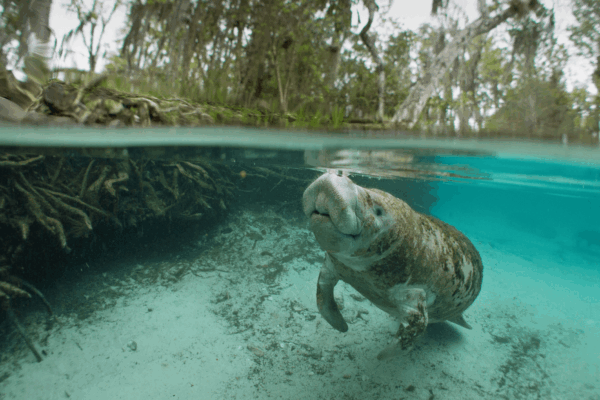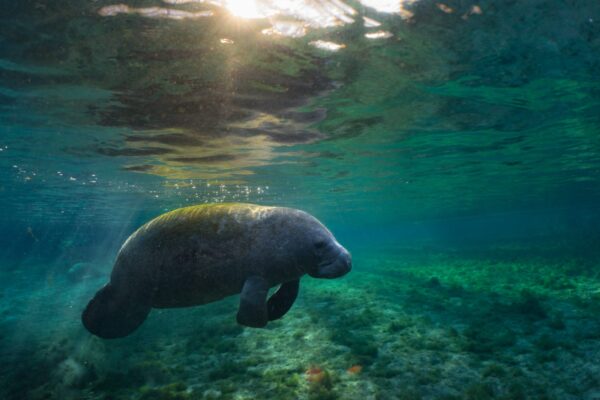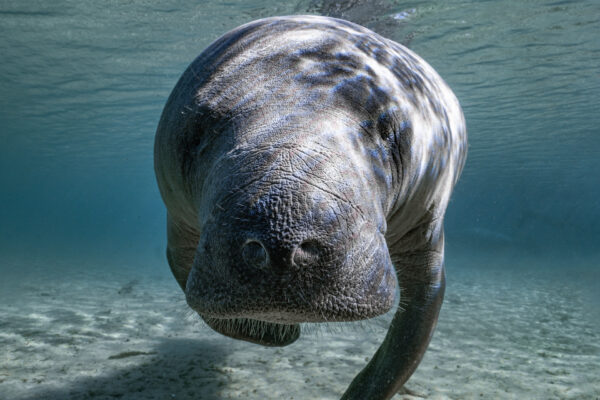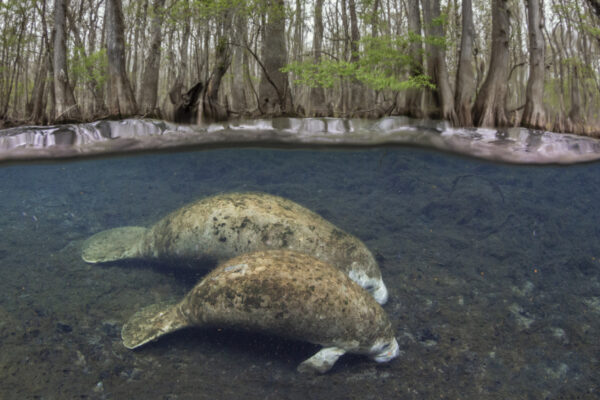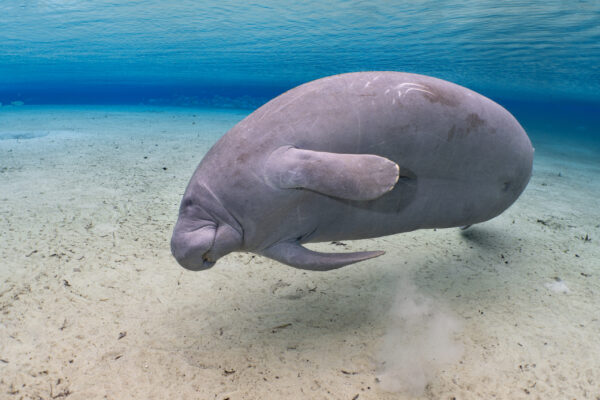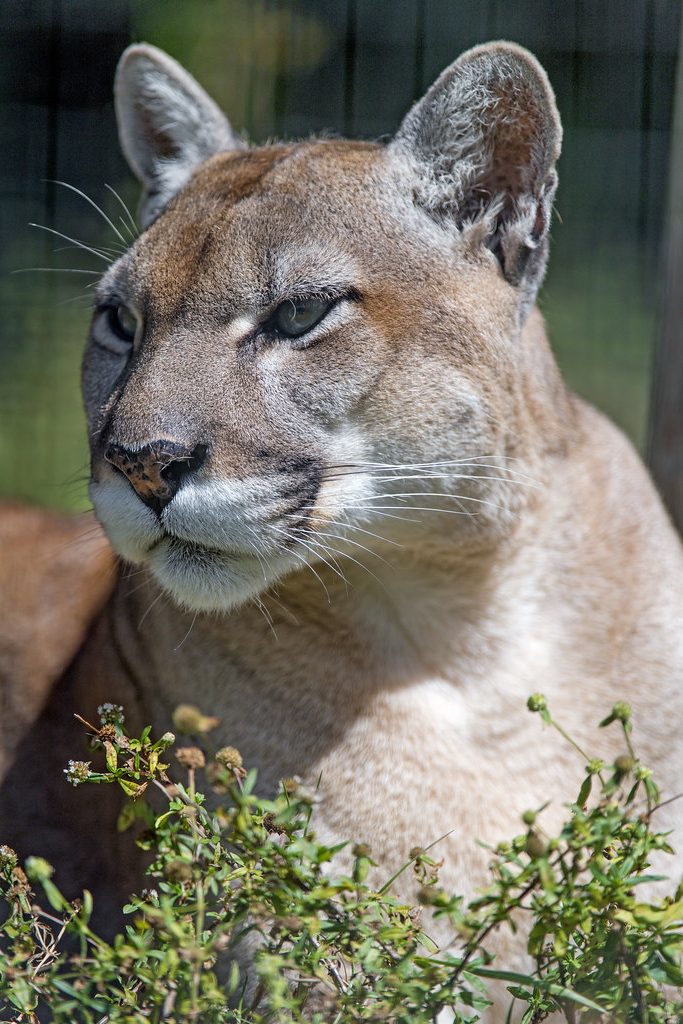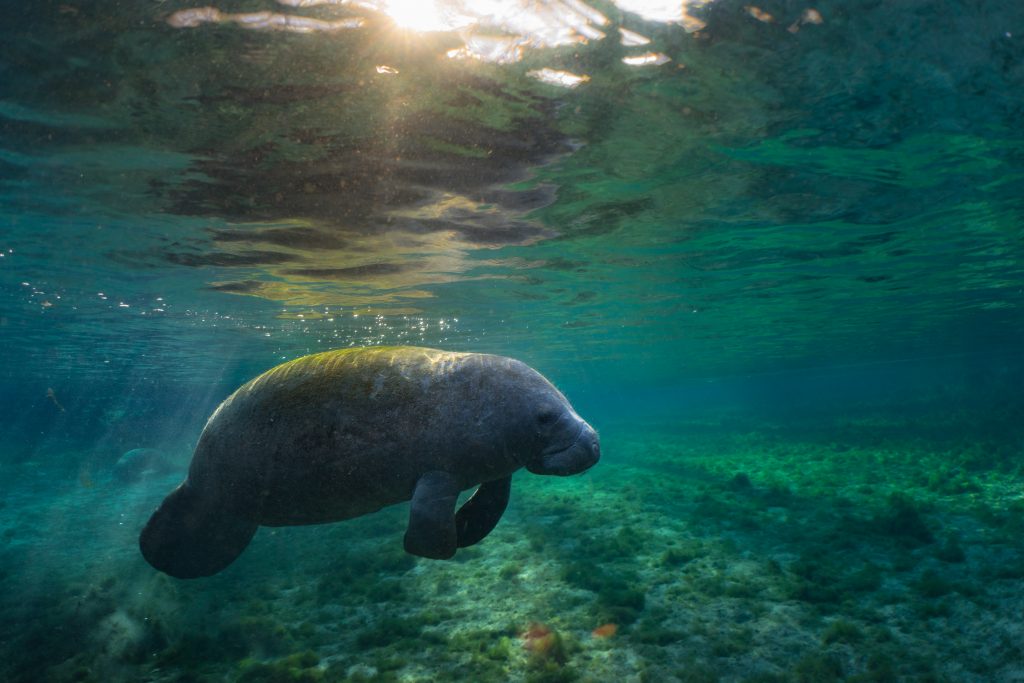The Florida manatee is one of Florida’s most iconic native species. These gentle giants are found throughout our coastal waters and rivers. Clean water and habitat are critical to the survival of the species, which is why the Florida Wildlife Federation is fighting for stronger water quality standards and habitat conservation. Protecting manatees also means safeguarding the health of Florida’s waterways for countless other species and future generations.
The Florida Manatee
Protecting the Florida Manatee
The Florida manatee (Trichechus manatus latirostris) is a subspecies of the West Indian manatee and an iconic marine mammal of Florida’s waterways. These gentle herbivores depend on seagrass beds in freshwater and estuarine habitats but face increasing threats from boat strikes, habitat loss, and declining water quality.
- Habitat: Rivers, springs, estuaries, coastal waters
- Population: Estimated at around 7,500 individuals
- Conservation Status: Listed as “Threatened” under the Endangered Species Act
Today’s Challenges
Florida’s manatees face growing threats that jeopardize their survival and the health of the state’s waterways. Pollution and algal blooms have led to widespread seagrass loss, causing starvation. At the same time , boat strikes remain a major cause of manatee deaths, while runoff from agriculture, urban development, and wastewater continues to degrade the water they depend on.
Manatees also depend on warm-water refuges to survive the winter, but the loss of natural springs and uncertainty surrounding power plant discharges put them at risk of cold stress. Without continued conservation efforts, these challenges will threaten the long-term future of Florida’s manatees and the ecosystems they call home.
Conservation in Action
The Florida Wildlife Federation is proud to be a part of the Reunite the Rivers Coalition, dedicated to restoring Florida’s interconnected ecosystems, improving water quality, and creating critical habitat for wildlife—particularly the Florida manatee.
Our efforts center on the restoration of the Ocklawaha River, a crucial step in revitalizing the iconic Great Florida Riverway—a 217-mile system connecting Silver Springs, the Ocklawaha River, and the St. Johns River to the Atlantic Ocean. Key to this initiative is the proposal to breach a portion of the Rodman Dam.
Breaching the dam will restore the natural flow of the Ocklawaha River, enhancing water quality and reopening essential migratory pathways for manatees to access historic warm-water habitats. These habitats are vital for manatee survival during colder months and will support a significant portion of Florida’s manatee population.
This action will also strengthen fisheries in the lower St. Johns and Ocklawaha Rivers, benefiting manatees by ensuring a healthier aquatic ecosystem. Through education, advocacy, and collaboration, we are working to ensure Florida’s waterways and manatees thrive for generations to come.
Learn about the Florida Manatee
Florida manatees are large, slow-moving marine mammals with rounded, gray bodies covered in sparse, bristly hairs. They can grow up to 13 feet long and weigh as much as 3,500 pounds, though most adults range between 800-1,200 pounds. Newborn calves are about 3-4 feet long and weigh around 60-70 pounds at birth.
Manatees have a paddle-shaped tail that helps propel them through the water, along with two front flippers that they use for steering and grazing on aquatic vegetation. Their small, whiskered snouts are adapted for foraging, with sensitive bristles (vibrissae) that help them detect and manipulate food. Unlike most marine mammals, manatees lack blubber and rely on warm water habitats to survive.
The Florida manatee has faced significant conservation challenges over the years but has made remarkable progress thanks to dedicated protection efforts. By the 1970s, manatee populations had declined drastically due to boat collisions, habitat loss, and entanglement in fishing gear. In 1973, the species was listed as Endangered under the Endangered Species Act, and protections were put in place to safeguard critical warm-water habitats and reduce human-related threats.
Over the following decades, conservation efforts, including boat speed regulations, habitat restoration, and public awareness campaigns, helped stabilize the population. In 2017, the Florida manatee was reclassified from Endangered to Threatened, reflecting population improvements. However, threats persist, including seagrass loss due to water pollution, cold stress events, and continued boat strikes.
FWF involvement:
- In 2021, Florida faced a devastating Unusual Mortality Event—over 1,100 manatees perished, more than 10% of the population—largely due to starvation from widespread seagrass loss. In response, FWF championed the introduction of the Manatee Protection Act of 2021 to restore endangered status, supported increased federal funding for rescue and rehabilitation, and pressed for stronger water-quality enforcement; while the bill did not advance, its goals remain central to ongoing efforts to secure lasting protections for this iconic marine mammal.
The most significant problems presently faced by Florida manatees are the loss of warm water habitats and injuries or deaths from boat strikes. Natural threats include harmful algal blooms, cold weather, tropical storms, hurricanes, tidal entrapments, and disease. As coastal development alters waterways, manatees lose access to the warm-water refuges they rely on for survival. Additionally, pollution and algal blooms have led to widespread seagrass loss, reducing their primary food source and contributing to starvation events in recent years.
Manatees are also highly vulnerable to boat collisions, which are one of the leading causes of manatee injuries and deaths. Their slow-moving nature and need to surface for air make them particularly susceptible to being struck by fast-moving watercraft. Propeller wounds and blunt force trauma from boat hulls can cause severe injuries, often leading to fatalities.
Florida manatees are generally solitary animals but may be found in small, loose groups, especially in warm-water refuges during the winter or when a mother is caring for her calf. During mating season, multiple males may gather around a single female in what is known as a mating herd. While they do not form strong social bonds, manatees are known to interact peacefully when they encounter each other.
Despite their large size, manatees are surprisingly agile swimmers. They can hold their breath for up to 20 minutes while resting but typically surface every few minutes to breathe. Manatees propel themselves forward using their powerful, paddle-shaped tails and use their front flippers for steering and stability. They are gentle and curious by nature, often investigating their surroundings with their sensitive whiskered snouts.
Manatees communicate using a variety of sounds, including chirps, whistles, and squeaks, particularly between mothers and calves. They also rely on body language to express discomfort or curiosity. If a manatee changes its behavior due to human presence—such as moving away quickly or avoiding an area—it is a sign that it feels disturbed. Observing manatees from a respectful distance helps protect these slow-moving marine mammals and ensures they can go about their natural behaviors without interference.
Florida manatees inhabit coastal waters, rivers, estuaries, and freshwater springs throughout the state. They rely on warm, shallow waters and are mostly found in seagrass meadows, tidal creeks, and natural springs, where they graze on aquatic vegetation. During the colder months, manatees seek out warm-water refuges, such as natural springs and power plant outflows, to survive, as they cannot tolerate prolonged exposure to water temperatures below 68°F.
Manatees are highly dependent on healthy aquatic ecosystems that provide food, shelter, and safe passage between habitats. Seagrass beds and freshwater vegetation are critical to their diet, and the loss of these food sources due to pollution and algal blooms poses a significant threat.
Florida manatees play a vital role in maintaining the health of aquatic ecosystems. As herbivores, they consume vast amounts of seagrass and other aquatic vegetation, helping to control plant growth and prevent overgrowth that could disrupt water flow and habitat balance. Their grazing also stimulates seagrass beds to regenerate, promoting healthy underwater ecosystems that support a wide range of marine life, including fish, crustaceans, and other aquatic species.
In addition to shaping plant communities, manatees contribute to nutrient cycling. As they digest and excrete plant material, they return essential nutrients to the water, supporting the productivity of seagrass meadows and wetland environments. This natural process helps maintain the balance of Florida’s coastal and freshwater ecosystems, benefiting other wildlife that depends on these habitats for food and shelter.
Although manatees are primarily solitary, they often gather in warm-water refuges during the winter months and may be found socializing in small groups while traveling or feeding. Their presence in Florida’s waterways serves as an indicator of ecosystem health, making their conservation essential not only for their own survival but for the overall balance of Florida’s marine and freshwater environments.
Florida Manatee (Trichechus manatus latirostris)
Kingdom: Animalia – Includes all animals, excluding plants and single-celled organisms.
Phylum: Chordata – Characterized by having a spinal cord.
Sub-phylum: Vertebrata – Animals with a backbone.
Class: Mammalia – Warm-blooded animals that nurse their young.
Order: Sirenia – A group of fully aquatic, herbivorous mammals.
Family: Trichechidae – The scientific family name for manatees.
Genus: Trichechus – Derived from Greek, meaning “hairy one,” referencing the manatee’s bristled body.
Species: manatus – Refers to the West Indian manatee, found in warm waters of the Atlantic.
Subspecies: latirostris – Identifies the Florida manatee as a distinct subspecies, known for its broad snout and reliance on warm-water habitats.
Florida manatees are herbivores, feeding primarily on a variety of aquatic vegetation. Their diet consists of seagrasses, freshwater plants, and algae, with some individuals consuming more than 100 pounds of vegetation per day to sustain their large bodies. Manatees use their prehensile upper lips to grasp and manipulate plants, while their molars are specially adapted for grinding tough vegetation.
Their diet varies depending on habitat and seasonal availability. In coastal and estuarine environments, they primarily graze on seagrass species such as manatee grass and turtle grass. In freshwater systems, they consume submerged and floating plants like hydrilla, water hyacinth, and eelgrass. Seagrass loss due to pollution and algal blooms has become a major concern, as it directly impacts their ability to find enough food.
Female manatees, called cows, typically reach sexual maturity between three and five years old and have their first calf between the ages of four and seven. Males, known as bulls, mature a bit later, between five and seven years.
During the breeding season, several bulls may gather and actively pursue a cow, forming what is known as a mating herd. Breeding can occur at different times within this group. Bulls play no role in raising the young and will leave once the breeding period is over.
While manatees can breed year-round, most births occur in the spring. Females have a long gestation period of about 13 months and a low reproductive rate, usually giving birth to just one calf every three to five years. Calves remain close to their mothers for up to two years, learning essential survival skills.
How to Help?
Protecting these gentle marine mammals requires collective action to restore their environment, reduce human-related threats, and advocate for strong conservation policies. One of the most significant efforts to help manatees is restoring the Ocklawaha River, which would reconnect vital warm-water habitat and improve water quality, providing a healthier ecosystem for manatees and other wildlife.
You can help by:
- Donating to support conservation efforts – Your support allows the Florida Wildlife Federation to advocate for policies that protect manatee habitats, restore waterways like the Ocklawaha River, and educate the public on responsible stewardship of Florida’s waters.
- Educating your community – Spread awareness about the importance of seagrass restoration, responsible boating practices, and pollution prevention. Encourage others to respect manatee speed zones and reduce their impact on Florida’s waterways.
- Advocating for wildlife-friendly policies – Support efforts to restore the Ocklawaha River and protect Florida’s warm-water habitats. Urge decision-makers to invest in seagrass restoration, enforce slow-speed zones in manatee areas, and address water pollution that threatens these iconic marine mammals.
Latest news about the Florida manatee
Florida Manatee F.A.Q.s
What should you do if you encounter a manatee?
Practice your ‘Manatee Manners’, by watching from a distance and allowing manatees to move freely. Do not touch, feed, or chase them, as this can alter their natural behavior and put them at risk. If you’re swimming or paddling nearby, move slowly and avoid splashing. Always follow manatee zone speed limits when boating to prevent collisions.
If you see an injured, dead, tagged, or orphaned manatee, or witness harassment, report it immediately to FWC, call 1-888-404-3922, email or text tip@myfwc.com, or use VHF Channel 16 on your marine radio.
Do manatees migrate?
Yes, manatees migrate seasonally. During the winter, they seek out warm-water refuges, such as natural springs and power plant outflows, to survive. In warmer months, they travel throughout coastal and freshwater habitats in search of food.
Why is restoring the Ocklawaha River important for manatees?
The Ocklawaha River is a vital link in the Great Florida Riverway, connecting the St. Johns River, and Silver River—all critical waterways for manatees. However, the construction of the Rodman Dam has blocked their access to these natural warm-water refuges, cutting them off from essential winter habitat. Restoring the Ocklawaha would reconnect this historic waterway, allowing manatees to migrate freely between the St. Johns River and the spring-fed waters of Silver Springs. This restoration would not only reopen vital migration routes but also improve water quality, restore natural flow, and provide greater access to food and shelter, ensuring manatees have the resources they need to survive.
Is it illegal to touch a manatee in Florida?
Yes, it is illegal to touch, harass, or disturb a manatee in Florida. Manatees are protected under the Marine Mammal Protection Act, the Endangered Species Act, and the Florida Manatee Sanctuary Act, which make it unlawful to touch, chase, feed, or interact with manatees in a way that alters their natural behavior.
Even if a manatee approaches you, you should not reach out to touch it. Interacting with manatees can make them more accustomed to human presence, increasing their risk of boat strikes and other dangers. The best way to protect manatees is to practice passive observation—watch from a distance and let them move freely in their natural habitat.
Why are manatees currently considered threatened, not endangered?
In 2017, the federal government reclassified the Florida manatee from endangered to threatened, based on scientific projections that the population would remain above 4,000 individuals over the next 100 years. However, the 2020-2021 Indian River Lagoon die-off, which resulted in the loss of hundreds of manatees due to widespread seagrass loss and starvation, raised serious concerns about long-term survival. With continued habitat degradation and recurring winter die-offs, conservationists warn that manatees remain highly vulnerable and in need of stronger protections.




